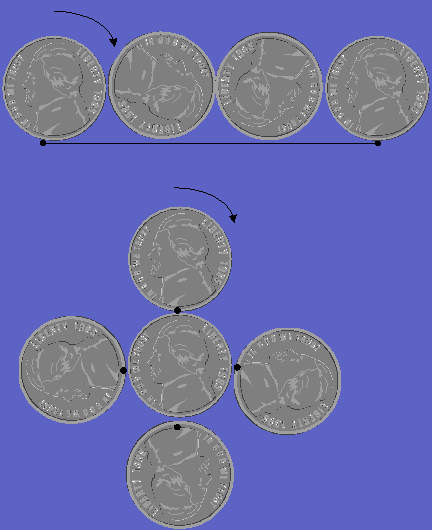On the other
hand, if the coin
slides along the other coin but keeps the same point of contact then it
also makes one rotation. The solution to the problem is to combine
these two motions to get two rotations.
A Better Idea
I
don't know about you, but I found this explanation to be
unsatisfactory. It wasn't that it was wrong; it just didn't seem to be
what I was looking for.
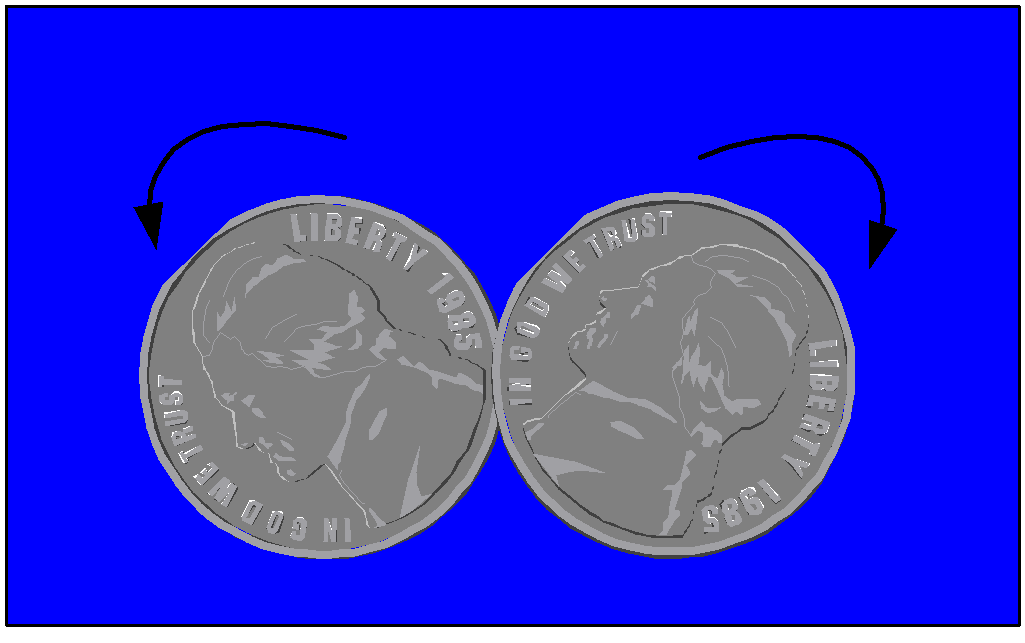
I wanted to relate this problem
to the simple case where the coins
act as two freely rotating enmeshed gears, with one turning once
clockwise and the other turning once counterclockwise
It took me a while to realize
that the answer was right in front of
me and that it was as plain as 1 - (-1) = 2, which is not quite as
obvious as 1 + 1 = 2.
If clockwise rotations are
assigned positive numbers then
counterclockwise numbers should be assigned negative numbers. The
difference between a clockwise rotation and a counterclockwise rotation
is 1 - (-1) = 2, which is the difference in the number of rotations in
the problem, since one coin rotated twice and the other didn't rotate
at all.
The simple case is not just
related to the original problem. The two
cases are equivalent, differing only in the vantage point of the
observer.
If we take coins turning in
opposite directions and place a tiny
observer on the coin rotating counterclockwise, then what does this
observer see? The observer will not be aware of the movement of its own
coin just as we do not sense the movement of the Earth. When the two
coins each rotate once, the other coin will appear to rotate twice
clockwise. Further, the other coin will also appear to make a single
clockwise revolution for the same reason that the rotation of the Earth
makes it appear as if the sun revolves around the Earth.
The Principle of
Relative Rotation
I could now formulate the Principle
of Relative Rotation: The
difference in the number of rotations of two objects is unchanged when
the observer's reference frame is rotating.
This still left the problem of
revolutions. How could we get from no
revolutions to one revolution? Well, no revolutions is the same as zero
revolutions, which falls between -1 and +1 rotation in the one case
just as one revolution falls between 0 and 2 rotations in the other.
Therefore, if revolutions are regarded as a special type of rotation,
then they can be fit into the general principle.
Geometric
Justification
To provide a geometric
explanation we must first determine how to measure the amount of
rotation.
First we choose a base line in
the reference system. Then we choose
an angle reference line in the rotating object and measure its angle A
with respect to the base line, as shown in the picture below on the
left.
The amount of rotation is the
difference in the angle A1
that the angle reference line makes with the base line before rotating
and the angle A2
that it makes with the base line after rotating.

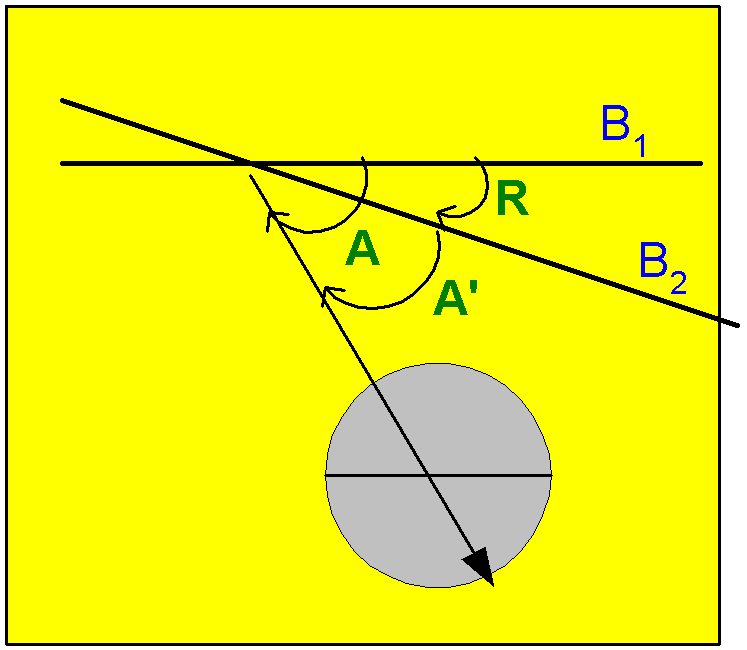
In the picture on the right
there are two base lines B1
and B2,
where B2
has been rotated through an angle of R with respect to B1.
B2
also goes through the intersection of B1
and the angle reference line. In this case it is obvious that the angle
A' that the angle reference line makes with respect to B2
is given by A' = A - R.
What if the second base line
does not go through the intersection of
the angle reference line with the first base line? The picture below
illustrates this case.

Keeping the line B2
parallel to its original orientation and sliding it to the right so
that it goes through the intersection of B1
with the angle reference line, the angles A' and R are unchanged and we
get the previous case. Again A' = A - R.
Imagine that at the start of
the rotational movement of several
objects that the two base lines coincide. The initial angles therefore
will be the same in both reference systems. If the second base line
rotates through an angle R while the various other objects rotate, then
in the second reference frame all the final angles will be reduced by
R. The differences between initial and final angles will also be
reduced by R. Thus all
rotations in the second reference frame
will be reduced by R. Therefore the difference between any two
rotations will be the same in the second reference frame as in the
first.
Yes, But What About Revolutions?
First we must determine what we
mean by a revolution: Draw the line L connecting the centers of two
objects O1
and O2.
A revolution between O1
and O2
can be defined as the change in the angle that L makes with the base
line.
Consider again the two coins
rotating in opposite directions.
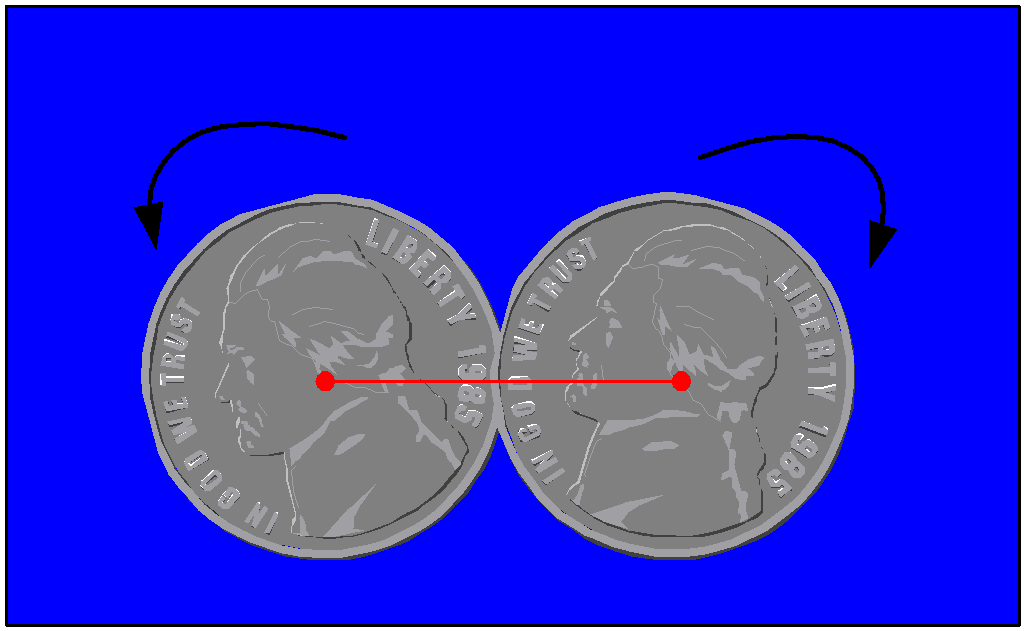
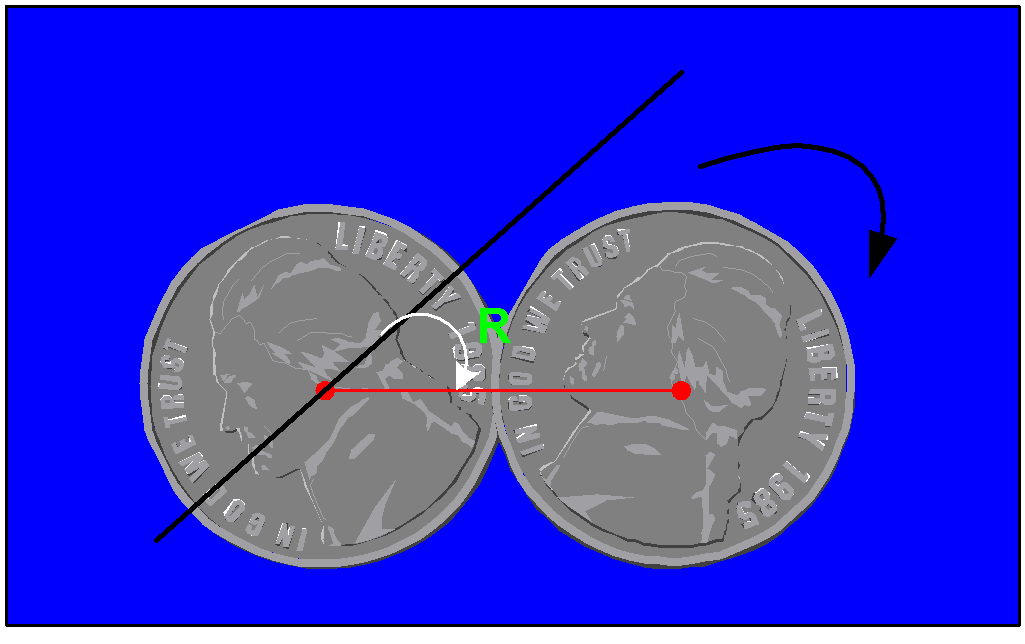
In the picture on the left the
line joining
the coin centers is shown. Both the base line and the line joining the
centers remain fixed and so there are no revolutions.
In the picture on the right,
the situation is shown as it appears to
the observer on the counterclockwise moving coin. The line joining the
centers appears to move clockwise and so the observer sees the other
coin making a revolution.
We may think of a revolution as
the rotation of the line joining the
centers and therefore the Principle of Relative Rotation applies
equally to it.
What Revolves Around What?
One
thing that may strike you as odd about the definition of revolutions is
that it does not provide any way of determining which object is
revolving around which. There is, in fact, no need to make a
distinction.
Consider a line in a plane. Rotate
the line
clockwise keeping one end fixed. Now go back to the original position
and perform the rotation keeping the other end fixed. The change in the
angle that the line makes with respect to a base line is the same in
each case. Consider a revolution between
two objects O1
and O2.
If an observer on O1
perceives O2 as
revolving around O1
by an angle R in a certain direction then the observer on O2
will perceive O1
as moving by R around O2
in the same direction.
On to Bigger Things
Having
mastered the rotation of coins I decided to take on the world, and the
moon as well. It helped considerably that the planets and moons in the
Solar System move in roughly the same plane.
When discussing the coins, I
made the assumption that they were
being viewed from above. If, for example, our observer were placed on
the bottom of a coin then all rotations would be perceived as being in
the opposite direction - clockwise would become counterclockwise and
vice verse. In discussing Earth, the Northern and Southern Hemispheres
are analogous to the top and bottom of a coin. In what follows the
assumption will be made that earth-bound observers are in the Northern
Hemisphere and observers in space are viewing from above the North
Pole. Please excuse my hemispherist bias.
Earth Rotations
Consider
first Earth rotations. Rotation of the Earth is not the same as a day.
To see why, consider the diagram below, which represents the Earth
revolving around the sun, as viewed from above the North Pole.
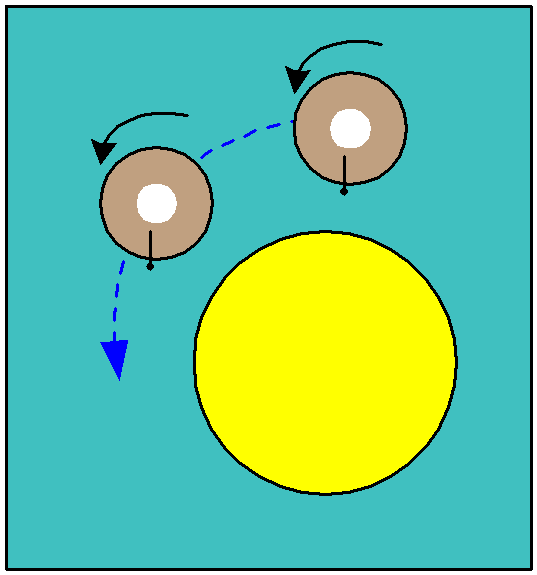
In the top position, the line on the
circle representing Earth indicates a location where it is noon.
In the next position, the Earth has
gone
through a complete rotation but it is not yet noon at the specified
location. The Earth will have to rotate a little further for this to
happen. Thus a day is longer than a rotation.
The difference between a day and a
rotation is
one way of explaining the changes in the night sky during the course of
a year. During a single rotation all of the constellations appear
overhead. The only ones that are visible are the ones that are overhead
at night and because rotations and days are out of synch, which stars
appear at night will differ during the course of a year.
The number of Earth rotations in a
year is
calculated as follows. To an observer on Earth, the Earth makes no
rotations and the sun appears to make 365 1
/4 clockwise revolutions around the Earth. We thus have:
revolutions - rotations = 365 1/4 -
0 = 365 1/4.
When viewed from outer space, the
Earth is
seen to go counterclockwise around the sun. Therefore, by the Principle
of Relative Rotations:
revolutions - rotations = -1 -
rotations = 365 1/4.
Earth rotations in a year = -366 1/4.
The
earth rotates 366 1/4 times counterclockwise in a year. The time to
make a rotation can be found by dividing 366 1/4 into (365 1/4 days *
24 hours/day) yielding a rotation time of about 23 hours and 56 minutes.
Moon Revolutions
On
Earth we observe that a lunar phase cycle, the time from one full moon
to the next, takes 29.5 days. Both the sun and moon appear to move
clockwise with the moon lagging behind. A phase cycle is the time
required for the sun to appear to make a lap relative to the moon, so
the quantity we are computing is sun revolutions - moon revolutions.
The number of these in a year is (365 1/4)/ 29.5 = 12.38. We thus have:
sun-Earth revolutions - moon-Earth
revolutions = 12.38.
From outer space, there is one
counter clockwise sun-Earth revolution, so by the Principle of Relative
Rotation,
-1 - moon-Earth revolutions = 12.38.
The moon makes 13.38 counterclockwise
revolutions per year. The time to make one revolution is (365 1/4 days)
/ 13.38, or about 27.3 days.
Note that although the rotation of
the Earth
affects the apparent revolutions of both the sun and moon, the Earth's
rotation was not involved in the above calculation, since both sun and
moon are affected equally by it.

HOME
